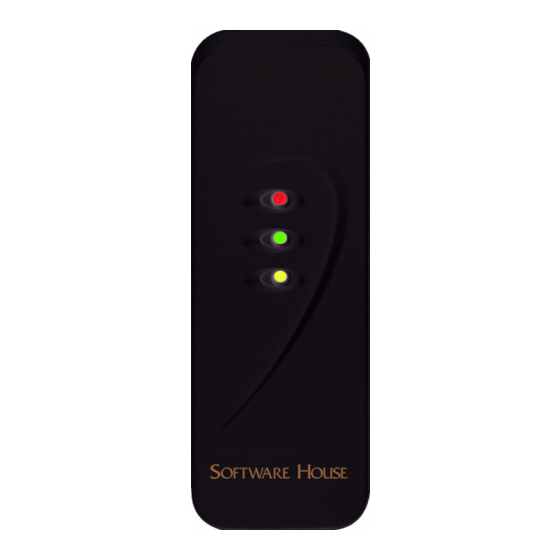Summary of Contents for Software House SWH-4000
- Page 1 Model SWH-4000 Multi-Technology Mullion 125 KHz and 13.56 MHz (Flex) Reader Installation Guide Version A0 Part Number UM-104 September 2005...
- Page 2 Troubleshooting ..........9 Model SWH-4000 Technical Specifications ..... . 10 FCC Digital Device Limitations .
-
Page 3: Introduction
INTRODUCTION The SWH-4000 reader will read Prox and Smart Cards at frequencies of both 125 kHz and 13.56 MHz. The reading capability includes, for Smart Cards, both unencrypted serial numbers and encrypted MIFARE® programmed sectors. Refer to Table 1 for a complete list of compatible standards and data. -
Page 4: Features
FEATURES Universal compatibility with most 125 kHz Prox (including all HID® Prox formats), all ISO 15693, and ISO 14443A credentials (badges, disk tags and key fobs). Reads both 125 kHz and 13.56 MHz credentials in the same reader. Electrical protection (reverse polarity diode protection on power lines). Data lines: high-speed transient voltage suppressor diodes. -
Page 5: Mounting
MOUNTING Mount the reader module directly to a metal door frame or wall and snap the front cover in place as indicated in Figure 1. FIGURE 1. Mounting Assembly... -
Page 6: Wiring
WIRING The SWH-4000 model has ten terminals as noted in Table 2. When attaching wires to the connector, strip off only the minimum insulation required (approx. 1/8'') and push the wire into the connector until the insulation is flush or inside the connector body. This is particularly critical for outdoor readers. - Page 7 Beeper Wiring Figure 2 shows how to wire the beeper so that it beeps when a valid card is presented to the reader. Terminal Block +12V AC or For internal beep, connect Pin 6 to Pin 1 as shown FIGURE 2. Beeper Wiring NOTE If you wire the beeper as shown in Figure 2, do not wire the beeper back to the controller.
-
Page 8: Installation Notes
INSTALLATION NOTES Unless otherwise specified in this manual, please follow these guidelines: 1. Shielded cable is recommended in electrically noisy environments. 2. You can use a local power supply for the reader. If so, don’t connect the power supply from the controller to the reader. The ground line of the local power supply must be connected to the power supply of the controller. -
Page 9: Troubleshooting
TROUBLESHOOTING If the operation of a component is in doubt, substitute a known good component and retry the system. Always verify wiring against the provided wiring information before powering up the reader. TABLE 4. Error Conditions and Possible Solutions Condition Possible Solutions None of the LEDs Check the following:... -
Page 10: Model Swh-4000 Technical Specifications
MODEL SWH-4000 TECHNICAL SPECIFICATIONS Cable Recommendations: 4 core (minimum), shielded, 22 AWG (minimum) cable. Connectors: 10 position, 3.5 mm Screw Terminals - Plug-In Certifications: FCC Part 15, CE and UL 294 Open Standards ISO 14443A Compliance: ISO 14443B (Depending on specific... - Page 11 Serial Number Read Fixed Wiegand bit stream option SmartFrame® encrypted MIFARE Sector read and conversion to Wiegand. Consult your Software House representative for available reconfiguration cards for your reader. Upgrade Complete upgrade capability using RS-485 port for reflashing of internal ROM.
-
Page 12: Fcc Digital Device Limitations
Operation with non-approved equipment or unshielded cables is likely to result in interference to radio and television reception. CAUTION: Changes or modifications not expressly approved by Software House for compliance could void the user’s authority to operate this equipment. -
Page 13: Ul Standards Compliance
CANADIAN RADIO EMISSIONS REQUIREMENTS This digital apparatus does not exceed the Class A limits for radio noise emissions from digital apparatus set out in the Radio Interference Regulations of the Canadian Department of Communications. Le present appareil numerique n'emet pas de bruits radioelectriques depassant les limites applicables aux appareils numeriques de la class A prescrites dans le Reglement sur le brouillage radioelectrique edicte par le ministere des Communications du Canada. -
Page 14: Ce Marking
SWH-3100 SWH-4000 SWH-1000 SWH-3000 SWH-5000 To obtain a copy, contact Software House and request the “Declaration of Conformity” document for Multi-technology readers. Software House 70 Westview Street Lexington, MA 02421 U.S.A. In case of alteration of the product, not agreed to by us, this declaration will lose its validity. - Page 16 Tyco International. Copyright 2005 Tyco International All rights reserved. Printed in Germany. Software House is a trademark of Sensormatic Electronics Corporation. MIFARE, SmartFrame, HID, DesFire, iCLASS, and CASI-RUSCO are registered trademarks of other companies not affiliated with Sensormatic. Software House...








Need help?
Do you have a question about the SWH-4000 and is the answer not in the manual?
Questions and answers